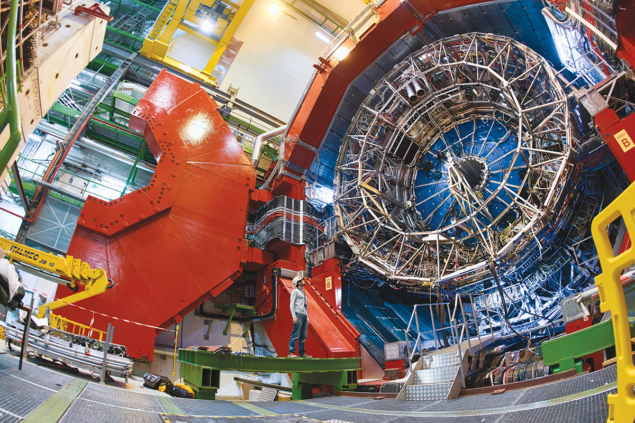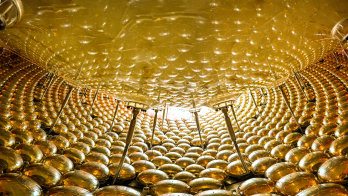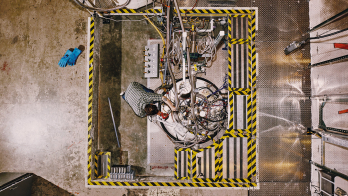Four technological masterpieces bestride the narrow beam pipe of the Large Hadron Collider, charting unexplored territory at the frontier of knowledge. But this is only possible thanks to the work of thousands of physicists and engineers. Ten years on from the first high-energy collisions, Mark Rayner interviews some of the foremost experts on what it took to keep these onion-like arrays of silicon and steel fighting fit.

Two detectors, both alike in dignity, sit 100 m underground and 8 km apart on opposite sides of the border between Switzerland and France. Different and complementary in their designs, they stand ready for anything nature might throw at them, and over the past 10 years physicists in the ATLAS and CMS collaborations have matched each other paper for paper, blazing a path into the unknown. And this is only half of the story. A few kilometres around the ring either way sit the LHCb and ALICE experiments, continually breaking new ground in the physics of flavour and colour.
Plans hatched when the ATLAS and CMS collaborations formed in the spring of 1992 began to come to fruition in the mid 2000s. While liquid-argon and tile calorimeters lit up in ATLAS’s cavern, cosmic rays careened through partially assembled segments of each layer of the CMS detector, which was beginning to be integrated at the surface. “It was terrific, we were taking cosmics and everybody else was still in pieces!” says Austin Ball, who has been technical coordinator of CMS for the entire 10-year running period of the LHC so far. “The early cosmic run with magnetic field was a byproduct of our design, which stakes everything on a single extraordinary solenoid,” he explains, describing how the uniquely compact and modular detector was later lowered into its cavern in enormous chunks. At the same time, the colossal ATLAS experiment was growing deep underground, soon to be enveloped by the magnetic field generated by its ambitious system of eight air–core superconducting barrel loops, two end-caps and an inner solenoid. A thrilling moment for both experiments came on 10 September 2008, when protons first splashed off beam stoppers and across the detectors in a flurry of tracks. Ludovico Pontecorvo, ATLAS’s technical coordinator since 2015, remembers “first beam day” as a new beginning. “It was absolutely stunning,” he says. “There were hundreds of people in the control room. It was the birth of the detector.” But the mood was fleeting. On 19 September a faulty electrical connection in the LHC caused a hundred or so magnets to quench, and six tonnes of liquid helium to escape into the tunnel, knocking the LHC out for more than a year.
You have this monster and suddenly it turns into this?
Werner Riegler
The experimentalists didn’t waste a moment. “We would have had a whole series of problems if we hadn’t had that extra time,” says Ball. The collaborations fixed niggling issues, installed missing detector parts and automated operations to ease pressure on the experts. “Those were great days,” agrees Richard Jacobsson, commissioning and run coordinator of the LHCb experiment from 2008 to 2015. “We ate pizza, stayed up nights and slept in the car. In the end I installed a control monitor at home, visible from the kitchen, the living room and the dining room, with four screens – a convenient way to avoid going to the pit every time there was a problem!” The hard work paid off as the detectors came to life once again. For ALICE, the iconic moment was the first low-energy collisions in December 2009. “We were installing the detector for 10 years, and then suddenly you see these tracks on the event display…” reminisces Werner Riegler, longtime technical coordinator for the collaboration. “I bet then-spokesperson Jürgen Schukraft three bottles of Talisker whisky that they couldn’t possibly be real. You have this monster and suddenly it turns into this? Everybody was cheering. I lost the bet.”
The first high-energy collisions took place on 30 March 2010, at a centre-of-mass energy of 7 TeV, three-and-a-half times higher than the Tevatron, and a leap into terra incognita, in the words of ATLAS’s Pontecorvo. The next signal moment came on 8 November with the first heavy-ion collisions, and almost immediate insights into the quark–gluon plasma.
ALICE in wonderland
For a few weeks each year, the LHC ditches its signature proton collisions at the energy frontier to collide heavy ions such as lead nuclei, creating globules of quark–gluon plasma in the heart of the detectors. For the past 10 years, ALICE has been the best-equipped detector in the world to record the myriad tracks that spring from these hot and dense collisions of up to 416 nucleons at a time.

Like LHCb, ALICE is installed in a cavern that previously housed a LEP detector – in ALICE’s case the L3 experiment. Its tracking and particle-identification subdetectors are mostly housed within that detector’s magnet, fixed in place and still going strong since 1989, the only worry a milli-Amp leak current, present since L3 days, which shifters monitor watchfully. Its relatively low field is not a limitation as ALICE’s specialist subject is low-momentum tracks – a specialty made possible by displacing the beams at the interaction point to suppress the luminosity. “The fact that we have a much lower radiation load than ATLAS, CMS and LHCb allows us to use technologies that are very good for low-momentum measurements, which the other experiments cannot use because their radiation-hardness requirements are much higher,” says Riegler, noting that the design of ALICE requires less power, less cooling and a lower material budget. “This also presents an additional challenge in data processing and analysis in terms of reconstructing all these low-momentum particles, whereas for the other experiments, this is background that you can cut away.” The star performer in ALICE has been the time-projection chamber (TPC), he counsels me, describing a detector capable of reconstructing the 8000 tracks per rapidity unit that were forecast when the detector was designed.
But nature had a surprise in store when the LHC began running with heavy ions. The number of tracks produced was a factor three lower than expected, allowing ALICE to push the TPC to higher rates and collect more data. By the end of Run 2, a detector designed to collect “minimum- bias” events at 50 Hz was able to operate at 1 kHz – a factor 20 larger than the initial design.
The discovery of jet quenching came simply by looking at event displays in the control room
Ludovico Pontecorvo
The lower-than-expected track multiplicities also had a wider effect among the LHC experiments, making ATLAS, CMS and LHCb highly competitive for certain heavy-ion measurements, and creating a dynamic atmosphere in which insights into the quark–gluon plasma came thick and fast. Even independently of the less-taxing-than-expected tracking requirements, top-notch calorimetry allowed immediate insights. “The discovery of jet quenching came simply by looking at event displays in the control room,” confirms Pontecorvo of ATLAS. “You would see a big jet that wasn’t counterbalanced on the other side of the detector. This excitement was transmitted across the world.”
Keeping cool
Despite the exceptional and expectation-busting performance of the experiments, the first few years were testing times for the physicists and engineers tasked with keeping the detectors in rude health. “Every year we had some crisis in cooling the calorimeters,” recalls Pontecorvo. Fortunately, he says, ATLAS opted for “under-pressure” cooling, which prevents water spilling in the event of a leak, but still requires a big chunk of the calorimeter to be switched off. The collaboration had to carry out spectacular interventions, and put people in places that no one would have guessed would be possible, he says. “I remember crawling five metres on top of the end-cap calorimeter to arrive at the barrel calorimeter to search for a leak, and using 24 clamps to find which one of 12 cooling loops had the problem – a very awkward situation!” Ball recalls experiencing similar difficulties with CMS. There are 11,000 joints in the copper circuits of the CMS cooling system, and a leak in any one is enough to cause a serious problem. “The first we encountered leaked into the high-voltage system of the muon chambers, down into the vacuum tank containing the solenoid, right through the detector, which like the LHC itself is on a slope, and out the end as a small waterfall,” says Ball.

The arresting modularity of CMS, and the relative ease of opening the detector – admittedly an odd way to describe sliding a 1500-tonne object along the axis of a 0.8 mm thick beam pipe – proved to be the solution to many problems. “We have exploited it relentlessly from day one,” says Ball. “The ability to access the pixel tracker, which is really the heart of CMS, with the highest density of sensitive channels, was absolutely vital – crucial for repairing faults as well as radiation damage. Over the course of five or six years we became very efficient at accessing it. The performance of the whole silicon tracking system has been outstanding.”
The early days were also challenging for LHCb, which is set up to reconstruct the decays of beauty hadrons in detail. The dawning realisation that the LHC would run optimally with fewer but brighter proton bunches than originally envisaged set stern tests from the start. From LHCb’s conception to first running, all of the collaboration’s discussions were based on the assumption that the detector would veto any crossing of protons where there would be more than one interaction. In the end, faced with a typical “pile-up” of three, the collaboration had to reschedule its physics priorities and make pragmatic decisions about the division of bandwidth in the high-level trigger. “We were faced with enormous problems: synchronisation crashes, event processing that was taking seconds and getting stuck…,” recalls Jacobsson. “Some run numbers, such as 1179, still send shivers down the back of my spine.” By September, however, they had demonstrated that LHCb was capable of running with much higher pile-up than anybody had thought possible.
No machine has ever been so stable in its operational mode
Rolf Lindner
Necessity was the mother of invention. In 2011 and 2012 LHCb introduced a feedback system that maintains a manageable luminosity during each fill by increasing the overlap between the colliding beams as protons “burn out” in collisions, and the brightness of the bunches decreases. When Jacobsson and his colleagues mentioned it to the CERN management in September 2010, the then director of accelerators, Steve Myers, read the riot act, warning of risks to beam stability, recalls Jacobsson. “But since I had a few good friends at the controls of the LHC, we could carefully and quietly test this, and show that it produced stable beams. This changed life on LHCb completely. The effect was that we would have one stable condition throughout every fill for the whole year – perfect for precision physics.”
Initially, LHCb had planned to write events at 200 Hz, recalls Rolf Lindner, the experiment’s longtime technical coordinator, but by the end of Run 1, LHCb was collecting data at up to 10 kHz, turning offline storage, processing and “physics stripping” into an endless fire fight. Squeezing every ounce of performance out of the LHC generated greater data volumes than anticipated by any of the experiments, and even stories (probably apocryphal) of shifters running down to local electronics stores to buy data discs because they were running out of storage. “The LHC would run for several months with stable beams for 60% of every 24 hours in a day,” says Lindner. “No machine has ever been so stable in its operational mode.”
Engineering all-stars
The eyes of the world turned to ATLAS and CMS on 4 July 2012 as the collaborations announced the discovery of a new boson – an iconic moment to validate countless hours of painstaking work by innumerable physicists, engineers and computer scientists, which is nevertheless representative of just one of a multitude of physics insights made possible by the LHC experiments (see LHC at 10: the physics legacy). The period running up to the euphoric Higgs discovery had been smooth for all except LHCb, who had to scramble to disprove unfounded suggestions that their dipole magnet, occasionally reversed in field to reduce systematic uncertainties, was causing beam instabilities. But new challenges would shortly follow. Chief among several hair-raising moments in CMS was the pollution of the magnet cryogenic system in 2015 and 2016, which caused instability in the detector’s cold box and threatened the reliable operation of the superconducting solenoid surrounding the tracker and calorimeters. The culprit turned out to be superfluous lubricant – a mere half a litre of oil, now in a bottle in Ball’s office – which clogged filters and tiny orifices crucial to the cyclical expansion cycle used to cool the helium. “By the time we caught on to it, we hadn’t just polluted the cold box, we had polluted the whole of the distribution from upstairs to downstairs,” he recalls, launching into a vivid account of seat-of-the-pants interventions, and also noting that the team turned their predicament into an opportunity. “With characteristic physics ingenuity, and faced with spoof versions of the CMS logo with straightened tracks, we exploited data with the magnet off to calibrate the calorimeters and understand a puzzling 750 GeV excess in the diphoton invariant mass distribution,” he says.
Now I look back on the cryogenic crisis as the best project I ever worked on at CERN
Austin Ball

With resolute support from CERN, bold steps were taken to fix the problem. It transpired that slightly-undersized replaceable filter cartridges were failing to remove the oil after it was mixed with the helium to lubricate screw-turbine compressors in the surface installation. “Now I look back on the cryogenic crisis as the best project I ever worked on at CERN, because we were allowed to assemble this cross-departmental superstar engineering team,” says Ball. “You could ask for anyone and get them. Cryogenics experts, chemists and mechanical engineers… even Rolf Heuer, then the Director-General, showed up frequently. The best welders basically lived in our underground area – you could normally only see their feet sticking out from massive pipework. If you looked carefully you might spot a boot. It’s a complete labyrinth. That one will stick with me for a long time. A crisis can be memorable and satisfying if you solve it.”
Heroic efforts
During the long shutdown that followed, the main task for LHCb was to exchange a section of beryllium beam pipe in which holes had been discovered and meticulously varnished over in haste before being used in Run 1. At the same time, right at the end of an ambitious and successful consolidation and improvement programme, CMS suffered the perils of extraordinarily dense circuit design when humid air condensed onto cold silicon sensor modules that had temporarily been moved to a surface clean room. 10% of the pixels short-circuited when it was powered up again, and heroic efforts were needed to re-manufacture replacements and install them in time for the returning LHC beams. Meanwhile, wary of deteriorating optical readout, ATLAS refurbished their pixel-detector cabling, taking electronics out of the detector to make it serviceable and inserting a further inner pixel layer just 33 mm from the beam pipe to up their b-tagging game. The bigger problem was mechanical shearing of the bellows that connect the cryostat of one of the end-cap toroids to the vacuum system – the only problem experienced so far with ATLAS’s ambitious magnet system. “At the beginning people speculated that with eight superconducting coils, each independent from the others, we would experience one quench after another, but they have been perfect really,” confirms Pontecorvo. Combined with the 50-micron alignment of the 45 m-long muon detector, ATLAS has exceeded the design specifications for resolving the momentum of high-momentum muons – just one example of a pattern repeated across all the LHC detectors.
As the decade wore on, the experiments streamlined operations to reach unparalleled performance levels, and took full advantage of technical and end-of-year stops to keep their detectors healthy. Despite their very high-luminosity environments, ATLAS and CMS pushed already world-beating initial data-taking efficiencies of around 90% beyond the 95% mark. “ATLAS and CMS were designed to run with an average pile-up of 20, but are now running with a pile-up of 60. This is remarkable,” states Pontecorvo.
Accelerator rising
At 10, with thousands of physics papers behind them and many more stories to tell, the LHC experiments are as busy as ever, using the second long shutdown, which is currently underway, to install upgrades, many of which are geared to the high-luminosity LHC (HL-LHC) due to operate later this decade. Many parts are being recycled, for example with ALICE’s top-performing TPC chambers donated to Fermilab for the near detector of the DUNE long-baseline neutrino-oscillation experiment. And major engineering challenges remain. A vivid example is that the LHC tunnel, carved out of water-laden rock 30 years ago, is rising up, while the experiments – particularly the very compact CMS, which has a density almost the same as rock – remain fixed in place, counterbalancing upthrust due to the removed rock with their weight. CMS faces the greatest challenge due to the geology of the region, explains Ball. “The LHC can use a corrector magnet to adjust the level of the beam, but there is a risk of running out of magnetic power if the shifts are big. Just a few weeks ago they connected a parallel underground structure for HL-LHC equipment, and the whole tunnel went up 3 mm almost overnight. We haven’t solved that one yet.”
Most of all, it is important to acknowledge the dedication of the people who run the experiments
Ludovico Pontecorvo
Everyone I interviewed agrees wholeheartedly on one crucial point. “Most of all, it is important to acknowledge the dedication of the people who run the experiments,” explains Pontecorvo of ATLAS, expressing a sentiment emphasised by his peers on all the experiments. “These people are absolutely stunning. They devote their life to this work. This is something that we have to keep and which it is not easy to keep. Unfortunately, many feel that this work is undervalued by selection committees for academic positions. This is something that must change, or our work will finish – as simple as that.”
Pontecorvo hurries out of the door at the end of our early-morning interview, hastily squeezed into a punishing schedule. None of the physicists I interviewed show even a smidgen of complacency. Ten years in, the engineering and technological marvels that are the four biggest LHC experiments are just getting started.







